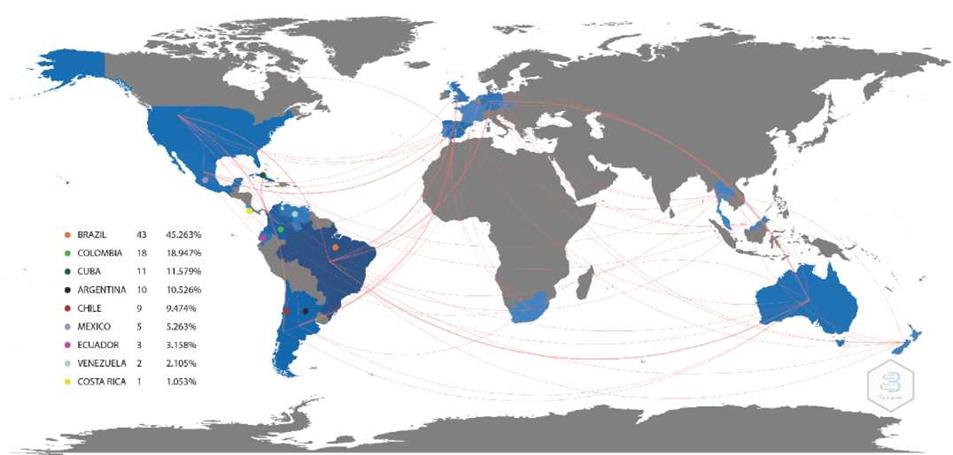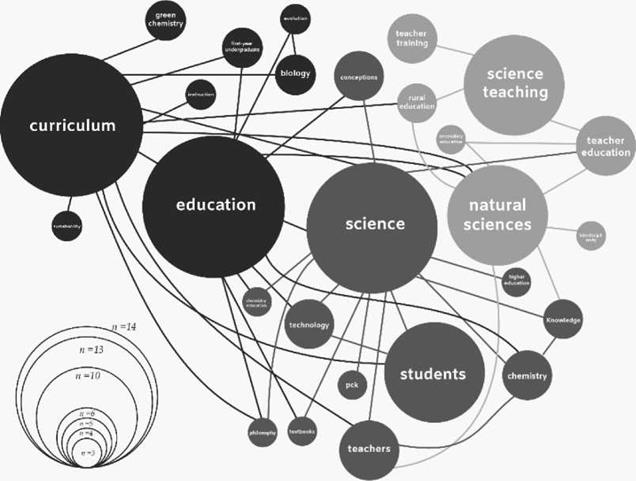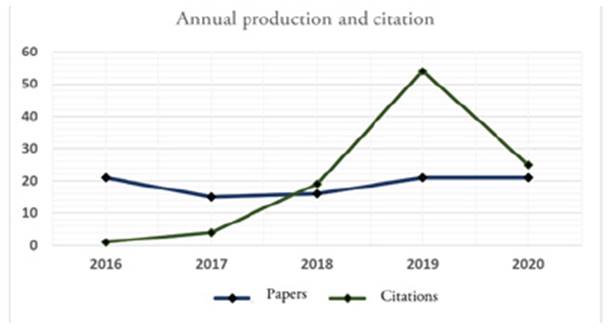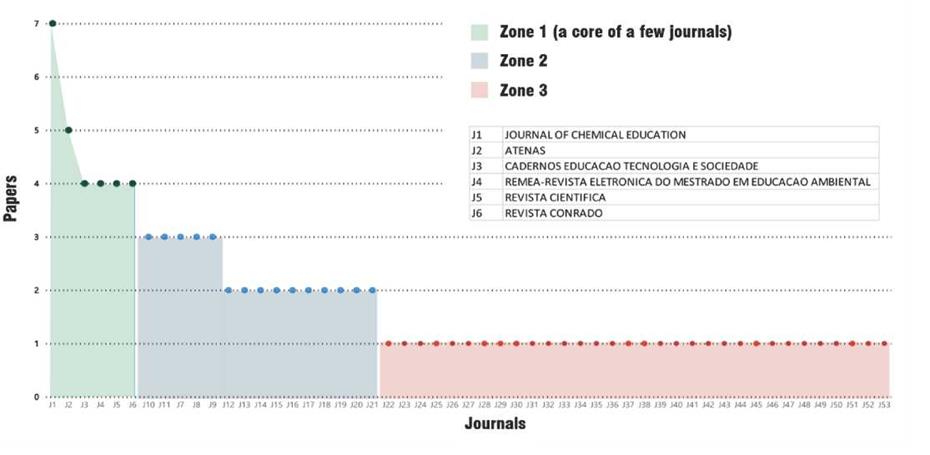This article1 is part of a research project on the curriculum of natural sciences whose purpose is to analyze the discourses and practices of this field. Its importance lies in the analysis of the implications of these discourses in the construction of the subject. Thus, the question is: what are the most relevant contributions written during the last decades on the evolutionary study of the curriculum for the teaching of natural sciences? This is the starting point to understand the principles and fundamentals aspect that explains the background and emergence of this as a structure derived from pedagogy.
The text is divided into four main sections: the first one presents a theoretical approach on the development of curriculum in natural sciences; the second section describes the methodological route; the third shows the descriptive results of the systematic review of research articles; and finally, the interpretative analysis of the documentary corpus is shown.
Curriculum in natural sciences: historical perspectives
The teaching of natural sciences 50 and more years ago represented a special interest mainly in Europe and the USA. In the 1970s, the main reforms in the curricula aimed at overcoming the traditional approaches of "teaching by transmission of knowledge". The contents of science were organized according to the internal logic of the discipline. Neither practical exercises nor experimentation were used in the classroom. Thus, the role of teachers was fundamental within this approach since they were the ones who transmitted the content. Additionally, the training of scientists was sought thanks to the new didactic methods that emphasized "science as questioning" or "learning by doing" (Matthews, 1991). During this same period, a series of projects were disseminated that proposed teaching science based on autonomous discovery and process methodology-that is, integrated science, in which curricular designs were adapted to these ideas in more directed ways and with a lesser conceptual focus (Gallego, 2007).
Then, in the 1970s and early 1980s, the didactics of natural sciences, assisted by the field of epistemology and psychology of learning, took on new projections. The contributions of (Kuhn 2019), (Toulmin (1972), Lakatos & Currie (1983), and Feyerabend (1981), among others, were necessary to question many of the theories on which the curricular reforms were elaborated. In addition, from the psychology of learning, the study of how learners understand the processes and the influence this has on the access to new concepts began to take on transcendence. In this way, challenges to the Piagetian ideology paradigm are addressed and projected, emphasizing that formal thinking is enough to access scientific knowledge. Piaget (1970), Ausubel (1978), and Novak (1988) were the main theoretical referents so that questions such as "how do we learn?" began to enter the field of research. For this reason, the idea that teaching is a set of diverse environments that aim to improving the learning that the school wants for the students is proposed.
Therefore, the idea that the verification that students' learning in natural sciences depends by the inquiry of concepts of experience and information, and the judgments they have in an established environment of knowledge, has caused approaches to science teaching based on the foundation of scientific concepts, starting from the conception they have acquired, and on innovations of conceptual, procedural, and attitudinal change. Based on these constructivist approaches, during the 1980s and 1990s, science education projects and programs emerged, focusing on the parallelism with the methodology of scientific research.
Thus, the orientation of the curriculum in the teaching of natural sciences is based on the solution of compulsory problems, seeking solutions to complex issues, in which the student needs to use knowledge already learned as a strategy that leads to the expected solution (Pozo et al., 1994). These constructivist strategies along with scientific competencies raise questions about how teachers teach based on the idea they have about science and its different methods (Adúriz et al., 2003).
Therefore, the science teacher as a researcher in teaching must be clear about what they should know and know how to do, as mentioned by Perez et al., (1999). He also insists on the importance of encouraging and guiding the teaching task collectively and permanently. The knowledge of the history of science, its methodological orientations, recent scientific developments, knowing how to select the appropriate content, and knowing the interactions between science, technology, and society must be involved in that process. This reflection was continued in Spain and Latin America.
In this sense, the research at school model, proposed by Rafael Porlán, is characterized by integrating didactics with school, daily, and scientific knowledge (Porlán & Rivero, 1998). In Latin America it has been taken up again as "didactic content knowledge" (DCK). This model starts with the knowledge of how teachers understand and use didactics in the classroom.
Returning to Perez et al., (1999), he mentions science, technology, and society must be known in its interactions. Chávez (2003, as cited in Cristancho, 2014) indicate that the positivist representations of science made from this are numerous. It is necessary to move towards an analysis of the sciences in technological creation, with social relevance and coherence with the context, involving citizen cooperation through interdisciplinarity seeking transdisciplinarity with an ontological, systemic, and contextualized vision of science and technology, besides a critical foundation. In this way, when analyzing science education, the different contexts and the interrelationships between students and teachers must be considered, to finally determine the learning-teaching and didactic relationships that will beget the trends in science education.
In other words, the field of natural sciences curriculum is open for research, analysis, and generation of new theories that respond to the problems of contemporary society.
Methodology
The research is structured under the documentary method: research articles published in Web of Science (WoS) are taken as analyzable data. The documentary corpus was obtained following these steps:
primary search: WoS was searched with the following equation: SUBJECT: ("curricu*" AND ("natural sciences" or "biology" or "chemistry" or "physical"), Indexes: SCI-EXPANDED, SSCI, A&HCI, ESCI.
temporal, thematic, and geographic refinement: since the objective of the research is to recognize the scientific production in Latin America on natural sciences curriculum from 2016 to 2020, the filters corresponding to type of document, WoS categories, countries of authorship and year of publication were used2.
abstract reading: 277 results were reviewed to determine their relevance. Articles with an object of study distanced from education were excluded.
At the end of these stages, 95 items were selected. This study comprises a descriptive part based on bibliometric instruments and indicators, for which the softwares VosViwer (Eck & Waltman, 2010) and Biblioshiny - Bibliometrix (Aria & Cuccurullo, 2017) were used; and an interpretative part, carried out through categorization and content analysis, for which five categories were raised a priori as a product of the review of titles and abstracts: (1) conceptions of science, (2) didactics and teaching, (3) teacher training, (4) interculturality, and (5) scientific research.
Curriculum in natural sciences in Latin America: publications in WoS
The descriptive statistical analysis of the documentary corpus allows showing the photography of the 95 publications that compose it. The following bibliometric indicators are taken as elements of capture:
Temporal evolution of production and citation
The scientific production in curriculum and science in Latin America has remained stable during the last five years, with an average of 19 articles per year (figure 1). The research interest in the area is constant, either due to the permanence of research teams or to the absence of junctures that might lead to a decrease of publications.
Regarding the citation of documents as a quantitative element of research impact, a total of 103 citations are found (table 1), with a maximum of citation in 2019 (54). Citations are concentrated in a total of 42 articles. The research project by Hurst et al. (2019) is the most cited (14). It is worth mentioning that the author team belongs to institutions in the United Kingdom, the Netherlands, Spain, South Africa, Argentina, and Mexico. That article presents the results of the study of perspectives and trends on chemical education with a sustainable approach with emphasis on systems thinking.
Table 1. Production and citation descriptions
Note. Citation frequency refers to documents published in WoS. Citation data were taken on August 22, 2021. The clarification is made given the changing nature of citation frequency.
Production by country and international collaboration
Although the criterion for inclusion of the texts was authorship by researchers belonging to Latin American institutions, given the international collaboration of the studies, the statistics show authorship from, for example, the United States, Australia, Germany, and Spain (figure 2).

Note. This figure was made based on data from the Biblioshiny software. The percentage was obtained from the sum of authorship by country (131).
Figure 2 Map of international collaboration.
The joint authorship between researchers from different institutions shows networks for the exchange of knowledge and perspectives: 15.7% of the documents analyzed are the result of joint studies that include non-Latin American authors; and 66.6% of them include a researcher from Latin America as corresponding author, which shows that most of the teams have been from the region with international support.
On the other hand, it stands out that, of the 84.21% of research with Latin American authors, 95% do not have any international link, meaning that the exchange of knowledge and international networks in the area has been reduced. Articles with joint authorship between Cuba and Colombia (Avendaño & Álvarez, 2019; González & Martínez, 2019; Pérez & Carballosa, 2018) and Cuba and Mexico (Pino & Filenko, 2017) stand out within the remaining 5%.
Bradford's law
Bradford's law indicates that if the elements of a set of journals are ordered in a decreasing order, in relation to the number of articles on an object under study, it is possible to show the core of journals dedicated to the subject of study, i. e., there is an unequal distribution in which approximately 20% of the journals produce 80% of the documentary corpus (Urbizagástegui, 1996). Figure 3 shows the production zones. It should be noted that the journals consolidated as a production nucleus can be a reference for the state of the art on natural sciences curriculum.
Co-occurrences
The recognition of thematic groupings in the field of curriculum in natural sciences allows evidencing the research trends that mobilize, transform, or configure the scientific field. For this reason, the analysis of clusters is used. From the mapping of the frequency and joint appearance of key words, the so-called co-occurrences are constructed: "maps that provide a visual representation of the structure of a field" (Eck, 2011, p. 68).
For the consolidation of the map, words with a frequency greater than or equal to three were included, with which the co-occurrence matrix of size 27 x 27 is configured (figure 4). It is elementary that the descriptors curriculum, education, and science have relevance in the co-word map; however, the connections with technology, rural education, conceptions, knowledge, and philosophy are highlighted.

Note. This figure was made based on the data provided by the VosViwer software.
Figure 4 Co-word analysis
Alongside the statistical groupings consolidated with the key words, a thematic grouping was made in four categories to carry out the interpretative approach of research trends in curriculum and natural sciences.
Conceptions of science
In this research project, there is an interest in the teachers' conception of science. Although the curricular approaches determine theories and topics to be addressed at school, the teacher in the classroom modifies and transposes these concepts based on their beliefs and conceptions.
Biological evolution, for example, is a theory that, even with scientific consensus, is a topic presented in a reserved manner in biological sciences curricula (Luvison, 2020; Tavares & Bobrowski, 2018). In this sense, Silva and Mortimer (2020) conducted an analysis in southern countries on the conception of biological evolution of biology teachers. The concepts of origin of life, Homo Sapiens, and evolution and its relationship with religious beliefs were investigated. Although the conceptions and biases are varied, a conflict between the religious and the scientific is recognized, which has influenced the biology class and implies an effort to improve the teaching of biological evolution in the tension between religious cosmogony and scientific evidence, in an analytical and critical sense of biological science.
Luvison (2020) proposes a pluralistic evolutionary worldview as a dialogue between empirical biology, theoretical biology, and philosophy of biology to avoid simplifying the study of evolution and to generate teaching processes and curricular practices in accordance with the 21st century.
However, the curriculum is not only influenced by the conception of a specific theory such as evolution in biology. The notion of science is determinant as a framework on which teaching is based. In that regard, González and Martínez (2019) propose the development of the curriculum from the science, technology, and society approach. They seek to recognize that development and scientific knowledge are related to technological innovations that respond to social problems of a community, which includes economic, environmental, and political components.
Teacher training
The modernization processes of a country entail political and economic transformations that, in a certain sense, seek the strengthening of human resources. Therefore, the training of science teachers arises as a response to these processes related to industrialization, development, and urbanization. For the Colombian case, for example, the curricular reform relative to the training of science teachers is related to the insufficiency of teachers prepared for the specificity of the area of natural sciences (Serrato, 2020).
For their part, curricular policies, besides seeking to respond to the social movements of a nation, are producers of a type of student and teacher. Between theory and practice there are tensions, dichotomies, and interweavings since the decision of how to teach is permeated by the discourses that give a standpoint in the face of reality and by experience, but also respond to the guidelines and theories that suggest "what is good" in a teaching practice. For the case of science teacher training, in the relationship between theory and practice, there is a tendency to approach the scientific practice to teaching practice, that is, the path followed in teaching and scientific learning must approach the processes that lead to the generation of knowledge itself of science but, at the same time, distance is taken in the recognition that the learning process has to do with a school culture rather than with the development of science (Ferreira et al., 2016).
In that context, teacher training does not only respond to theoretical approaches in university courses. It has to do with a constant process, with daily experiences that allow the teacher to reflect on his own work (Rodrigues et al., 2020). There must be an incessant questioning in which the conditions and responses of students are analyzed, and in which methodological possibilities for scientific learning are drawn. Teacher training is not only responsibility of the state or of higher education institutions but is part of the own daily processes of the teacher as a trainer of themself (Bedin & Pino, 2018).
However, although the teacher is continuously trained in his daily exercise, the curriculum of the university programs of teaching natural sciences must have a strong practical component that is configured "as a moment of development of capacities, abilities, and skills, implying the construction of new knowledge in the face of action" (Rodrigues, 2018, p. 1457). In this way, they will have the spaces to relate the theoretical to the practical prior to their teacher internship.
Interculturality
The flexibility of the curriculum in natural sciences implies involving social and cultural issues of the subjects in training. Therefore, whether in the development of curricula or in class decisions, linking ancestral knowledge specific to each culture is necessary, besides considering ethnic and cognitive diversity and gender issues, which make up the complex universe of the classroom.
For an indigenous community, for example, nature, flora, and fauna have different meanings other than a biological object of study. Nature indissoluble symbiotic relationships are established and go beyond the simple use of resources. They consider that there are gods, souls, companions, and allies of life in nature. In consequence, curriculum development in these environments should not move away from those interests and knowledge, because in addition to being a factor for the loss of traditions and customs, it discourage the study of natural sciences in indigenous students (Acosta, 2016). Similarly, popular knowledge can be part of science teaching, as a space for the possibility of inserting the intercultural into the classroom with topics such as: medicinal herbs and their impact on the human organism, traditional foods, processes of conservation and treatment of food, or environmental pollution in the management of crops or mining (Avendaño & Álvarez, 2019).
Likewise, the particularities of students with some type of cognitive or physical disability should be considered in the natural sciences classroom, so that the student is neither relegated in the experiments brought to class nor in the activities of approaching a certain scientific notion, since inclusion is assumed as a process that goes beyond the physical presence in the classroom (Taverna et al., 2019).
Didactics and teaching
The curricular renovations carried out in an educational system that seeks educational quality are complemented with the design and implementation of teaching strategies and methods by teachers that transcend the magisterial teaching that reduces in students the possibility of creating hypotheses, predicting, explaining, and interpreting phenomena of natural sciences, abilities proper to their learning (Blanchar-Anez, 2020). In view of this, research related to curriculum in natural sciences has a thematic correspondence with didactic exercises and teaching strategies. Next the topics approached in the research projects analyzed are shown:
Didactic content knowledge (DCK)
The experience of natural sciences teachers has been investigated from the components of the DCK: purpose of teaching a certain topic or issue; difficulties that students will have; curriculum; instructional strategies and content representations; evaluation; the teaching context; and didactics of the discipline (Melo et al., 2016). In that sense, Goes et al. (2020) found that teachers with more experience perform activities oriented to the application of disciplinary content, while novice teachers focus on content instruction.
Language and orality
Reading, writing, and oral skills are important in the teaching of natural sciences since they are part of the way of representing the processes and characteristics of phenomena. Therefore, beyond learning the contents of the area, the teacher should strive for the development of these skills (Candela, 2020), so that, besides promoting the learning of disciplinary knowledge, the discursive skills with which scientific knowledge is generated and circulated are developed (Andueza, 2016).
Similarly, bilingualism is an important factor in the teaching and learning of science since knowledge of the English language, for example, allows the opening to discourses and research in science and technology so that the conceptual knowledge available in the native language can be expanded, complemented, or enriched (Apa-Terrero et al., 2019; Archila & Truscott, 2020).
Application of science in the real world
The interaction and observation of real-world objects and phenomena can be the focus of science teaching. Getting students to conduct inquiry, prediction, and explanation of scientific events has its basis in the interaction with real problems (Batista-Freyre et al., 2016; Candela, 2020). Project work is a methodological strategy based on this perspective (Pérez & Carballosa, 2018). On this basis Garcês et al. (2018) present an experience in the teaching of biochemistry through the methodology of problem-based learning, where three joint projects were developed on diabetes, hypothyroidism, and lactose intolerance in order to generate learning about metabolic diseases. Besides the acquisition of knowledge on the subject, the experience allowed teamwork and the development of communication skills in writing and orality, along with the approach and reflection on the problems of contemporary society.
Scientific investigation
The development of activities that allow the student to follow the steps of scientific research enables the learning of scientific knowledge. Activities that lead from initial reflection and prediction, through observation and data collection, to interpretation and analysis, allow students to develop a personal scientific experience that enables the development of skills in natural sciences (Parra et al., 2018, Silva & Galembeck, 2017).
Under this perspective, Parra et al. (2018) present the sequence of a class of RC Circuits, in which an experimentation exercise is performed. This consisted of the assembly of the circuit, taking voltage and current reading, the elaboration of tables and graphs from the data collected, and the preparation of a descriptive report on the work done. The activity allowed the student to become familiar with RC circuits prior to the theoretical instruction of it. In this way it was possible to improve the learning of the students evidenced is their grades.
Use of information and communication technologies (ICT)
The use of ICT in the classroom has evidenced a positive relationship with learning since they allow, beyond the visualization of content, the monitoring and control of experiments (Luca et al., 2017). Regarding visualization, educational videos are a resource that transcends the physical space of the classroom and can be used without limit of space or time. In this sense, Vera et al. (2019) made educational videos on "chemical equations" that were edited and published as a complement to class activities. Thus, students had unlimited explanations from the teacher for the approach of different exercises and problems.
For their part, Soares et al. (2018) opted for the use of a multimedia game to contribute to the teaching of natural sciences. The authors conclude that the digital educational resource combines the potential of the game for promoting inquiry, wonder, and debate based on the interest of young people in the use of digital devices, which enables the learning of scientific content.
Conclusions
The academic production in curriculum and natural sciences in Latin America has remained stable during the last five years, evidencing the validity and importance of research development in the area, along with the existence of many research projects that can support future ones.
In terms of scientific production by country, Brazil has an important dominance, which is an indication that the theoretical reviews carried out in the area require a review of the production in Portuguese-the discourse in Latin America is not only in English or Spanish, but there is an important niche in the Portuguese language.
The natural sciences curriculum in Latin America is related to educational practice, with teaching and learning strategies developed by teachers, who seek to learn science as a joint work with state curricular renovations. Nevertheless, it is also related to the consolidation of a theoretical field that involves the epistemology of science and the understanding and analysis of the particularities of the Latin American social environment.


















